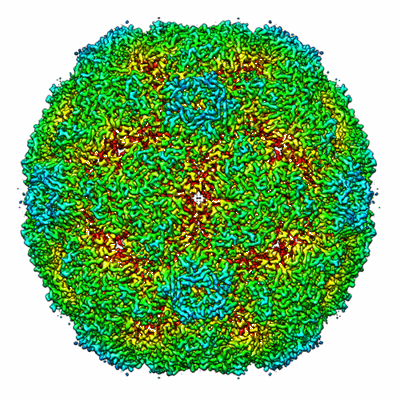EMD-30287
Cryo-EM structure of A particle Coxsackievirus A10 at pH 7.4
EMD-30287
Single-particle3.6 Å
 Deposition: 18/05/2020
Deposition: 18/05/2020Map released: 22/07/2020
Last modified: 27/03/2024
Sample Organism:
Coxsackievirus A10
Sample: Coxsackievirus A10
Fitted models: 7c4t (Avg. Q-score: 0.504)
Deposition Authors: Cui Y, Peng R ,
Gao GF
,
Gao GF  ,
Qi J
,
Qi J 
Sample: Coxsackievirus A10
Fitted models: 7c4t (Avg. Q-score: 0.504)
Deposition Authors: Cui Y, Peng R
 ,
Gao GF
,
Gao GF  ,
Qi J
,
Qi J 
Molecular basis of Coxsackievirus A10 entry using the two-in-one attachment and uncoating receptor KRM1.
Cui Y,
Peng R  ,
Song H
,
Song H  ,
Tong Z
,
Tong Z  ,
Qu X,
Liu S,
Zhao X,
Chai Y,
Wang P,
Gao GF
,
Qu X,
Liu S,
Zhao X,
Chai Y,
Wang P,
Gao GF  ,
Qi J
,
Qi J 
(2020) PNAS , 117 , 18711 - 18718
 ,
Song H
,
Song H  ,
Tong Z
,
Tong Z  ,
Qu X,
Liu S,
Zhao X,
Chai Y,
Wang P,
Gao GF
,
Qu X,
Liu S,
Zhao X,
Chai Y,
Wang P,
Gao GF  ,
Qi J
,
Qi J 
(2020) PNAS , 117 , 18711 - 18718
Abstract:
KREMEN1 (KRM1) has been identified as a functional receptor for Coxsackievirus A10 (CV-A10), a causative agent of hand-foot-and-mouth disease (HFMD), which poses a great threat to infants globally. However, the underlying mechanisms for the viral entry process are not well understood. Here we determined the atomic structures of different forms of CV-A10 viral particles and its complex with KRM1 in both neutral and acidic conditions. These structures reveal that KRM1 selectively binds to the mature viral particle above the canyon of the viral protein 1 (VP1) subunit and contacts across two adjacent asymmetry units. The key residues for receptor binding are conserved among most KRM1-dependent enteroviruses, suggesting a uniform mechanism for receptor binding. Moreover, the binding of KRM1 induces the release of pocket factor, a process accelerated under acidic conditions. Further biochemical studies confirmed that receptor binding at acidic pH enabled CV-A10 virion uncoating in vitro. Taken together, these findings provide high-resolution snapshots of CV-A10 entry and identify KRM1 as a two-in-one receptor for enterovirus infection.
KREMEN1 (KRM1) has been identified as a functional receptor for Coxsackievirus A10 (CV-A10), a causative agent of hand-foot-and-mouth disease (HFMD), which poses a great threat to infants globally. However, the underlying mechanisms for the viral entry process are not well understood. Here we determined the atomic structures of different forms of CV-A10 viral particles and its complex with KRM1 in both neutral and acidic conditions. These structures reveal that KRM1 selectively binds to the mature viral particle above the canyon of the viral protein 1 (VP1) subunit and contacts across two adjacent asymmetry units. The key residues for receptor binding are conserved among most KRM1-dependent enteroviruses, suggesting a uniform mechanism for receptor binding. Moreover, the binding of KRM1 induces the release of pocket factor, a process accelerated under acidic conditions. Further biochemical studies confirmed that receptor binding at acidic pH enabled CV-A10 virion uncoating in vitro. Taken together, these findings provide high-resolution snapshots of CV-A10 entry and identify KRM1 as a two-in-one receptor for enterovirus infection.
